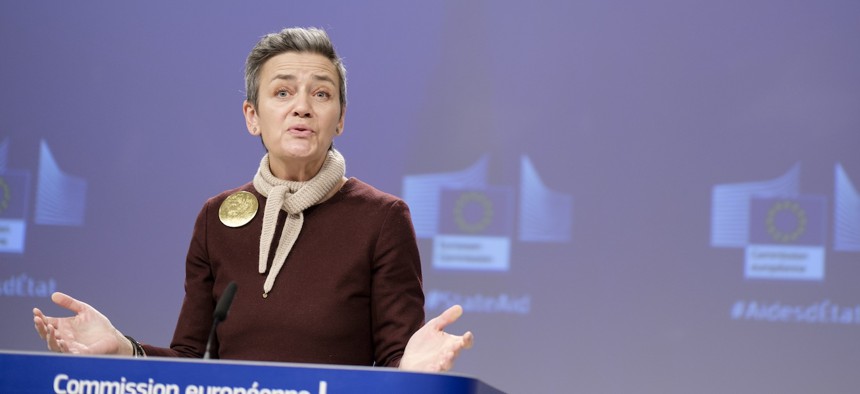US, EU update shared AI taxonomy, unveil new research alliance

EU technology policy official Margrethe Vestager, shown here at a press conference in February 2024, says she's hopeful US-EU conversations about AI safety will lead to "tangible" cooperation. Thierry Monasse/Getty Images
At the conclusion of the sixth meeting of the US-EU Trade and Technology Council, leaders focused on creating uniformity in AI terminology and continuing transatlantic collaboration.
The U.S. and European Union Trade and Technology Council have updated their repository of shared definitions of artificial intelligence terminology, as allied nations work to establish a shared understanding of how to securely leverage AI systems with a rights-centered approach.
After the sixth U.S.-EU TTC meeting held in Leuven, Belgium this past week, representatives from both governments found common ground on AI-related topics, announcing both an updated EU-U.S. Terminology and Taxonomy for Artificial Intelligence and continued AI-centric collaboration on Friday.
The updated taxonomy includes 13 new terms and updates 24 terms from the first iteration of the document. New terms include data augmentation, knowledge representation, prompt, training data, AI system, data leakage, and deep fakes, among others. These updates follow external expert commentary based on the first edition, collected between Oct. 27, 2023 and Nov. 24, 2023.
Amended terms include trustworthy AI, model, neural network, human values for AI, human-centric AI, AI accuracy, machine learning, data poisoning and synthetic data.
“By soliciting input from a broader network of experts, the document can better reflect diverse
perspectives and expertise contributing valuable insights to enhance the overall quality of the work undertaken by the experts of [working group 1],” the document reads.
The group also unveiled a new research alliance called AI for Public Good.
“Through this groundbreaking initiative, EU-U.S. scientific cooperation in AI is channelled to foster innovative research that can set the groundwork to advance societal well-being,” the announcement reads. The collaboration will focus on applying AI systems to areas like energy optimization, emergency response, urban reconstruction and extreme weather forecasting.
“In the coming months, scientific experts and ecosystems in the EU and the United States intend to continue to advance their collaboration and present innovative research worldwide,” the announcement said.
Margrethe Vestager, the executive vice president for the European Commission’s Europe Fit for the Digital Age strategic priority, added that, following the TTC discussions on aligning approaches to developing and using AI systems, future work will focus on tangible outcomes, like benchmarks, methodologies and harmonizing regulatory approaches for AI technologies between both the U.S. and EU.
“The most recent thing is the dialogue that we both think will lead to something much more tangible when it comes to the cooperation between the U.S. Safety Institute and our AI office,” she said. “I think one of the good things for citizens is that where we in the beginning diverged on platform regulation, we are now in a much more collaborative manner.”
Continued dialogues between both jurisdictions will further implement the December 2022 Joint Roadmap on AI governance between the U.S. AI Safety Institute and the EU’s AI Office.
U.S. Commerce Secretary Gina Raimondo told reporters during a press conference in Belgium on Friday that leadership from the U.S. AI Safety Institute — housed within the National Institutes of Standards and Technology — has launched a dialogue with the EU AI office on their individual approaches and mandates to deepen collaboration.
“Technology and the use of emerging technology has changed the game totally in economic security, in national security,” Raimondo said. “AI is changing the game again for everything, and AI collaboration between their office and our Safety Institute is strong, will get stronger, all led by the TTC.”
This agreement follows the EU’s proposal of a landmark AI Act —introduced in 2021 and passed by the EU Parliament in March of this year — which serves as the first comprehensive legal framework mandating how AI and machine learning systems can be deployed in society.
Within the TTC, officials have been making moves toward a united playing field for AI as the industry continues to grow.
Gaurav Pal, the CEO of stackArmor and one of the industry members of the USAISIC, told Nextgov/FCW the TTC’s latest work can ensure the U.S. helps drive standards development for AI technologies and ensure U.S. private sector competitiveness in the global economy.
“In some respects, the EU is a little ahead with the passage of the EU AI Act,” Pal said. “So the fact that the EU and the U.S. are coming together, I think is great, and I think what that essentially means to me is that the potential is we will have one set of standards and compliance frameworks rather than just having silos.”
The Information Technology Industry Council welcomed the outcomes of the sixth TTC meeting, but noted officials should focus on near-term outcomes, such as advancing AI cooperation and conformity, strengthening trade agreements and accelerating research in other emerging tech fields like quantum information sciences and 6G.
“We’re encouraged that leaders on both sides of the Atlantic have heeded industry’s call to strengthen the process and functionality of the TTC to deliver impactful results in the years to come,” said ITI CEO Jason Oxman in a press release “The commitments announced today on key issues including AI, semiconductors, and 6G take steps to advance bilateral cooperation but more work must be done to create meaningful progress.”
NEXT STORY: US-UK safety pact could shape the future of AI






